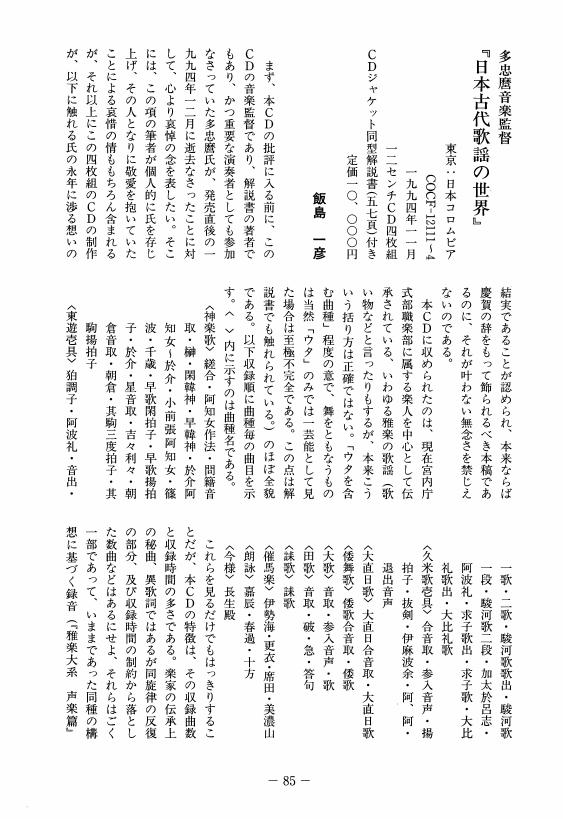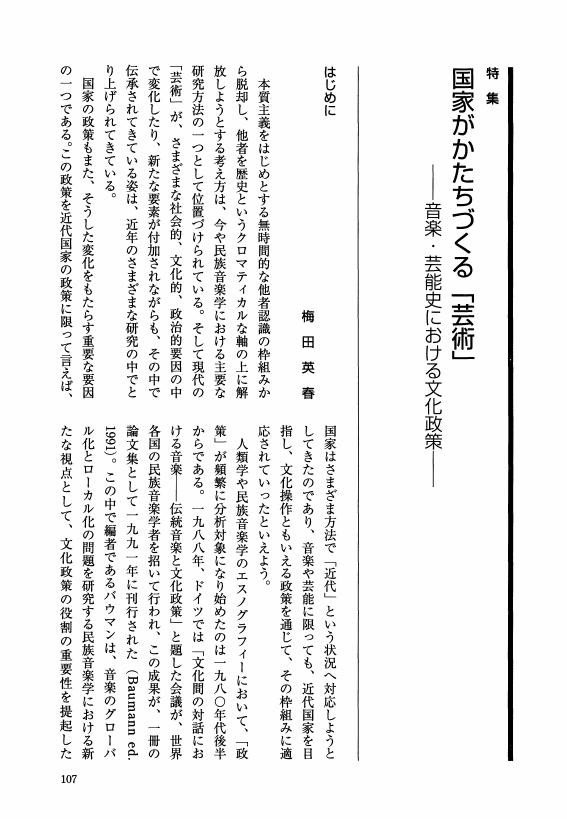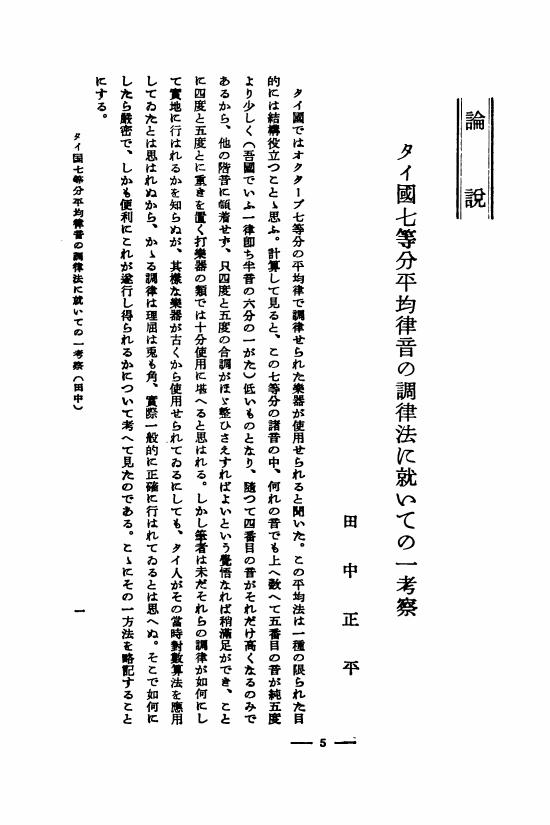1 0 0 0 一九二〇~三〇年代における大和流ご詠歌の成立過程
- 著者
- 新堀 歓乃
- 出版者
- 社団法人 東洋音楽学会
- 雑誌
- 東洋音楽研究 (ISSN:00393851)
- 巻号頁・発行日
- vol.2008, no.73, pp.63-75, 2008
ご詠歌は日本に伝わる宗教音楽のひとつであり、主に在家の仏教信者が四国遍路などの巡礼や葬式などの儀礼でご詠歌をうたうほか、稽古事としてもこれを伝習している。本稿は、現在に伝わるご詠歌諸流派の基礎を形作った大和流を対象に、その成立過程を明らかにする. 大和流は一九二一年、山崎千久松によって創始された。千久松はご詠歌の基本となる節を十一に整理し、ご詠歌の普及と仏教信者の教化を図って大和流の伝承団体「大和講」を設立した。大和講はその長である講主と、講主の下でご詠歌を伝承する多くの講員から成るが、千久松は自らが講主となってご詠歌の指導に当たり講員を増やしていった。<br>こうして大和講が成立すると、ご詠歌の伝承が大きく変容した。第一に、大和講はご詠歌の歌詞と節を記した歌集を全国発売して伝承の統一を図った。第二に、ご詠歌の歌い手が検定試験に合格すると階級が取得できるという制度を置いて、日本の諸芸能に見られるような家元制度と同様の伝承組織を形成した。第三に、詠唱技術を競う全国規模のコンクールを開催するようになった。こうして大和講は、中央の本部が全国各地の支部を統括するという一大組織を築くことができた。<br>大和講が全国に広く普及することができた要因として最も重要と思われるのが、家元制度と同様の伝承組織を形成したことである。大和講では、一定の階級を取得した者が講主に代わってご詠歌を指導するため、講主自身が直接伝授に当たることなく多くの弟子を抱えることができる。これは家元制度に特徴的なもので、大和講ではこうした制度を備えたために伝承者を増やして一大組織を築くことができたと考えられる。
1 0 0 0 OA 『日本古代歌謡の世界』
- 著者
- 飯島 一彦
- 出版者
- The Society for Research in Asiatic Music (Toyo Ongaku Gakkai, TOG)
- 雑誌
- 東洋音楽研究 (ISSN:00393851)
- 巻号頁・発行日
- vol.1996, no.61, pp.85-88, 1996-08-20 (Released:2010-02-25)
1 0 0 0 OA 琴歌譜の音楽的解釈の試み
- 著者
- 林 謙三
- 出版者
- 社団法人 東洋音楽学会
- 雑誌
- 東洋音楽研究 (ISSN:00393851)
- 巻号頁・発行日
- vol.1965, no.18, pp.67-102,en4, 1965-08-20 (Released:2010-11-30)
1 0 0 0 印度の民謡 (一)
- 著者
- 関 鼎
- 出版者
- 社団法人 東洋音楽学会
- 雑誌
- 東洋音楽研究 (ISSN:00393851)
- 巻号頁・発行日
- vol.1967, no.20, pp.29-48, 1967
本稿は印度の民謡の単なる紹介であるということを最初に断わっておかなければならない。<BR>印度は亜大陸である。その面積はソ連を除いた全ヨーロッパの面積にほぼ匹敵し、その人口は前記ヨーロッパのそれよりも約一五パーセントを上回る。そしてこの亜大陸は、北のカラコルムの氷河地帯、南の熱帯の波の打ち寄せるコモリン岬、東の深いジャングルに覆われたアッサムの丘陵地帯、西の荒涼としたバルチスタンの砂漠地帯、あるいはヒマラヤ山系の高い山々と深い谷間、まったく平坦なヒンダスタン平原等その自然においてまったく変化に富んでおり、その住民は、風貌を異にし皮膚の色を異にしたさまざまな人種で、それらがこの異なった自然環境の中で異なった神に帰依し、異なった言葉を話し、異なった風俗習慣を持ち、そしてもっとも原始的なジャングルの奥の生活からもっとも近代的な都市生活までのさまざまな生活を営なんでいる。印度の民謡はこれらをそのままに反映して、それぞれ特色を持ち、変化に富み、そしてそれらが互いに入り交り縺れ合ってまったく複雑である。<BR>この亜大陸の文化は「印度文化」あるいは「ヒンヅー文化」と呼ばれ、しばしば中国文化および西アジア文化と並べられてアジアの三大文化とされる。そして、印度文化の特徴は「 多様性の中の統一」 という言葉で説明される。しかし民謡の場省は、少なくとも私の聞いた限りにおいては、その多様性は容易に見出すことは出来るとして、一つの印度民印度の民謡 二九 (29 ) 印度の民謡 三〇謡としての統一をそこに見出すことは出来ないように思われる。今日、パキスタンの文化はしばしば西アジアの文化として考えられているので、民謡もまたインドとパキスタンに分けて考えなければならないかも知れない。しかし、このように二つに分けて考え、それぞれに統一を見出そうとしてもその結果は同じであるし、また、古典音楽にならって南北二つに大別して眺めて見てもその答はやはり同様である。<BR>しかしながら、今日まで私が耳にすることの出来た印度の民謡は、莫大な数にのぼるこの亜大陸の民謡のごく一部に過ぎない。したがって、私の聞くことの出来た民謡を基にこれ以上印度の民謡を論じることは、盲人が象の脚をなでて象を論じるとなんら変りはない、現在ここで私が印度の民謡について出来る唯一のことは、私の集めることの出来た民謡を楽譜にして、出来るだけ多く紹介することである。<BR>今日、印度の民謡の音楽の面はあまり研究されておらず、したがって、これに関する著書や論文、それに資料となる楽譜は非常にその数が少ないので、私がここに紹介する印度の民謡の楽譜が、この方面に興味を持っておられる方々にとってなんらかの役にたつことが出来ればまことに幸である。<BR>以下紹介する楽譜について一言述べておかなければならない。<BR>これらの楽譜はすべてインド放送局およびパキスタン放送局の作製した録音テープより採譜したもので、録音テープはすべて武蔵野音楽大学および私の所蔵するものであり、市販されているレコードよりのものは二切含まれていない。採譜は福田芳野および私が共同で行なったものである。<BR>これらの民謡の中には、放送のためにいくらか整備されているものもあるが、それらも将来現地採集の際の一つの手がかりとなると考えられるのでここに紹介することにした。<BR>半音よりさらに狭い微分音程の記譜に関しては、その楽譜のところで説明を加える。 (30 ) <BR>拍子記号および縦線は、ただ楽譜を読み易くするためのもので、したがって西洋音楽におけるように、縦線の次の音符は強拍となるとは限らない。<BR>一つの歌において、繰り返しごとに旋律の一部が多少異なっているものがあるが、その場合にはもっとも多く歌われている旋律を選んで採譜した。<BR>なお、ここでいう印度は地理的にみた印度である。この場合、セイロンやネパールも当然この中に含まれなければならないのであるが、紙面に限りがあるので、これらの国の民謡は省くことにした。また、チベット、アフガニスタン、イランなどの民謡を比較のためにここに紹介すべきであると考えたが、これらもまた同様の理由で省くことにした。これらの国の民謡は、機会があれば改めて紹介したいと思う。
1 0 0 0 ジェンダーと音楽学:問題点と可能性
- 著者
- 井上 貴子
- 出版者
- 社団法人 東洋音楽学会
- 雑誌
- 東洋音楽研究 (ISSN:00393851)
- 巻号頁・発行日
- vol.1997, no.62, pp.21-38,L2, 1997
The purpose of this paper is to explore how one can apply the recent advances in gender theory to musicology, concentrating on concerns about feminist criticism and the historicizing of gender. I will use the post-structuralistic concept of gender, because I believe that this is a rigorous approach to theorizing gender and most effectively avoids <i>ghettoization</i>. This approach also transcends historical periods, areas and genre boundaries.<br>Gender theory has been the most important concept for feminists, rallying many people to join the debate. Feminists have asserted that the subjective identity of men/women is a social and cultural construction. The wide acceptance of this conceptualization, however, has led to social and cultural determinism: producing descriptive accounts of gender roles as a static dichotomic order ruled by the inherent logic of a certain society or period, supporting the idea of cultural relativism. In the case of musicology, feminist musicologists who attempted to reestablish women as the subject, have discovered women composers and musicians who have been ignored or concealed by leading musicologists. It is at this moment important that women studies are not relegated to a marginal and supplemental sphere which would serve to reify the existing belief of unequal gender relations based on biological differences.<br>To surmount such a static dichotomy, the strategic theory must be made based on the issues raised by feminism. In the larger field of art, linguistic and visual representations such as literatures, paintings, films, performances and so on, which can give concrete images of women, have drawn attention, but music has received much less. This might be due to the existence of strong belief in the autonomy of music because of the lack of concreteness in sound. Recent studies, however, have made it clear that music, which has been the last stronghold of <i>autonomous art</i>, is greatly influenced by ideologies and the larger societies. Without dispelling such a belief and recognizing the politics of art —any type of power related to the construction and practice of meanings in a society—, gender theory can not be effectively applied to musicology.<br>In an important development, feminist criticism has been applied to music. The most specific feature of musicology might be the ability of analyzing musical sound itself as well as notations, visualized texts of music. Feminist music criticism tries to explicate how meanings of musical sound are constructed: the process of articulating musical discourses through gendered discourses. Susan McCraly, the most well-known musicologist in this field, starts by rejecting the idea of <i>autonomous art</i> and then tries to bring to light the idea that music and its processes operate within the larger political arena. She analyzes not only worded music such as <i>opera</i> but also <i>absolute music</i>.<br>We should recognize gender issues raised by feminists are related to men as well as women: men as the transcendental or universal subject in a patriarchal society now become the mere male subject. Gender music criticism including feminist music criticism, has already started to be developed.<br>History of women apparently seems to acquire a certain status, considering the numerous books and articles that have been recently published. Have the leading historians indeed neglected it as having nothing to do with economic and political history? Such a phenomenon is called <i>ghettoization</i>. As a strategy for surmounting this, the theory submitted by Joan W. Scott has inspired many scholars. She regards the historicizing of gender as the explicating the ways of producing the meanings of gender in different contexts; the exposing the concealed power relation through paying attention to the politics of constructing meanings.<br>When her theory is applied to writing history of music,
- 著者
- 山寺 美紀子
- 出版者
- 東洋音楽学会 ; [1936]-
- 雑誌
- 東洋音楽研究 = Journal of the Society for Research in Asiatic Music (ISSN:00393851)
- 巻号頁・発行日
- no.80, pp.1-19, 2014
1 0 0 0 書評 山寺美紀子著『国宝『碣石調幽蘭第五』の研究』
- 著者
- 遠藤 徹
- 出版者
- 東洋音楽学会 ; [1936]-
- 雑誌
- 東洋音楽研究 = Journal of the Society for Research in Asiatic Music (ISSN:00393851)
- 巻号頁・発行日
- no.78, pp.133-136, 2012
1 0 0 0 OA 東谷護著『進駐軍クラブから歌謡曲へ-戦後日本ポピュラー音楽の黎明期』
- 著者
- 岩井 正浩
- 出版者
- The Society for Research in Asiatic Music (Toyo Ongaku Gakkai, TOG)
- 雑誌
- 東洋音楽研究 (ISSN:00393851)
- 巻号頁・発行日
- vol.2006, no.71, pp.158-161, 2006-08-31 (Released:2010-09-14)
- 著者
- 早稲田 みな子
- 出版者
- 社団法人 東洋音楽学会
- 雑誌
- 東洋音楽研究 (ISSN:00393851)
- 巻号頁・発行日
- vol.2002, no.67, pp.61-80,L7, 2002
The contact that immigrants maintained with their homeland is one of the important determinants of the immigrant culture. However, this factor has been rarely emphasized in the studies on immigrant cultures as well as on Japanese Americans. The studies on immigrant cultures tended to focus on the interplay of cultural elements originating from the host society and those the immigrants bring from their home, while the studies on Japanese Americans tended to emphasize a process of Japanese American's Americanization, acculturation, and their upward movement toward the America's middle class through the successive generations. This study attempts to focus on the element undervalued in these past studies —a tie between immigrants and their home culture —to gain new insights into the Japanese American musical culture in pre-World War II southern California.<br>The Japanese immigrants in pre-World War II southern California maintained close contact with their home culture through the successive waves of touring Japanese artists from Japan who performed and/or taught their musical arts in the United States. This study views these Japanese performance artists as “cultural ambassadors, ” and examines their roles and influences in the immigrant community.<br>There were two major forces that attracted a large number of touring Japanese artists to the United States. One was the Japanese artists' own ambitions to achieve some success outside Japan. The other was the Japanese immigrants' strong attachment and longing for their home country. Coming from nationalist Japan of the Meiji period (1868-1912) and encountering racism and cultural conflict in the foreign country, the Japanese immigrants reinforced their Japanese identity and looked toward Japan as their authentic cultural model.<br>In this pro-Japan immigrant community, the touring Japanese artists played the following three major roles to affect the immigrant musical culture:<br>1) The role as a provider of contemporary Japanese musical arts and entertainment.<br>Through the overseas performances by the Japanese artists, Japanese immigrants were able to enjoy the musical arts and entertainment that were popular in Japan at that time, and thus, they could maintain an intimate cultural tie with “contemporary” Japan.<br>2) The role as a teacher and promoter of Japanese performance arts.<br>Some of the Japanese artists not only performed, but also taught their arts to the Japanese immigrants, and sometimes even organized the local performance groups within the immigrant community. There were artists who were invited from Japan as instructors for the immigrant-based performance groups. The Japanese artists, thus, greatly contributed to the development of Japanese performance arts among the immigrants, and enhanced Japanese culture within the immigrant community.<br>3) The role as a catalyst for the immigrants' acceptance of western musical culture.<br>Although the majority of the Japanese immigrants were yet unfamiliar with western art music, they paid a great deal of attention to the Japanese professionals of western art music who performed in the United States, because the immigrants highly regarded those artists as the Japanese elites successfully assimilated into western culture. Through these Japanese professionals, the immigrants gained access to western musical culture in the United States, and also raised their self-confidence and pride as Japanese.
1 0 0 0 OA 歐米人の琵琶西方起源説とその批判
- 著者
- 岸邊 成雄
- 出版者
- 社団法人 東洋音楽学会
- 雑誌
- 東洋音楽研究 (ISSN:00393851)
- 巻号頁・発行日
- vol.1936, no.1, pp.41-56, 1936 (Released:2010-11-30)
1 0 0 0 OA 国家がかたちづくる「芸術」
- 著者
- 梅田 英春 塚原 康子 濱崎 友絵
- 出版者
- The Society for Research in Asiatic Music (Toyo Ongaku Gakkai, TOG)
- 雑誌
- 東洋音楽研究 (ISSN:00393851)
- 巻号頁・発行日
- vol.2006, no.71, pp.107-137, 2006-08-31 (Released:2010-09-14)
- 参考文献数
- 15
1 0 0 0 三味線研究への手引 (要旨)
- 著者
- 吉川 英史
- 出版者
- 社団法人 東洋音楽学会
- 雑誌
- 東洋音楽研究 (ISSN:00393851)
- 巻号頁・発行日
- vol.1958, no.14, pp.233, 1958
三味線に関する種々の問題を、主として外国人の読者を対象として欝いた案内文である。 <BR>(I) 名称三味線、三弦、三線などの関係を述べる。 <BR>(II) 起原<BR>日本に渡来する以前の、三弦のそもそもの起りについての諸説を紹介する― <BR>(1) 田辺尚雄= ネーフエル説 <BR>(2) 岸辺成雄= クブズ (火不思) 説 <BR>(3) 林謙三= セタール説 <BR>(III) 東洋の三弦と日本の三味線との比較<BR>中国の三弦と、日本の三味線との相異を胴皮、胴木、駒、上駒、首部 (海老尾) 、撥などの、形状又は材料などについて述べる。 <BR>(IV) 三味線の構造と各部の名称<BR>日本内地の三味線の構造と各部の名称を述べ、場合によつては纏の名称の語意についても説明した。 <BR>(V) 日本への伝来と改造<BR>伝来史の通説を中心に、若干の異説を述ぺた、改造について琵琶の与えた役割を述べ、特にサワリの工夫と完成について略述した。 <BR>(IV) 調弦法 (調子) <BR>三味線の主要調弦法の三種を主とし、臨時的・派生的調弦法にも触れ、調弦法に多く種類のある理由を述べた。 <BR>(VII) 奏法<BR>三味線の構え方、左手と右手の使い方、バチの握り方などを述べ、奏法も流派によつて違う点を述べた。さらに、三味線においても音色の問題が重要であることと、三味線の特色であるメロデイー楽器とリズム楽器の二重性格を指摘しておいた。
1 0 0 0 OA 管絃雅楽の篳篥譜の旋法
- 著者
- 篠田 健三
- 出版者
- 社団法人 東洋音楽学会
- 雑誌
- 東洋音楽研究 (ISSN:00393851)
- 巻号頁・発行日
- vol.1967, no.20, pp.1-28, 1967-12-20 (Released:2010-11-30)
管絃雅楽を対象とした研究は古来かなりの数にのぼっている。新しい研究では、これらの先蹤を是非とも尊重しなければならぬし、なかんずく、いかに限定せられた対象を取扱う場合でも、雅楽の負う歴史的な背景を十分に念頭に置いていなければならない。個々の楽曲についての発生、伝来、編曲、演奏、伝承の歴史を細密に調べることが必要なゆえんである。また、雅楽の音階、旋法等、音楽理論にようて解明さるべきものに対しては、あたかも中世ヨーロッパ教会楽がつとにその理論を整えていたのと同様、古くから相当に整理された理論をもっているのであるから、それらの理論について十分な検討を行ない、もし、不備であるならばただにそれを訂正するのみでなく、いかなる原因で不備な理論が作られかつ信ぜられるに至ったかをも、理論自体の歴史的な伝承の上に即して明らかにしなければならない。また、総じて、現行の演奏をそのまま直ちに雅楽の古姿と同じであると見なすことはできない。その遷移の模様は、古譜の正読、古理論の正解、伝承上の口伝、伝承上の経緯、周辺の諸音楽の理解などの総合知識をもって、雅楽全般、楽曲ごと、さらに、楽曲の個々の部分ごとに細心緻密な検討を行なうことによって解明されなければならない。これらを解明することは、雅楽が単に古くかっ大規模な音楽であったというにとどまらず、また、中絶することなく管絃雅楽の篳篥譜の旋法一 (1) 管絃雅楽の篳篥譜の旋法二今日まで伝承されてきたというばかりでなく、実に日本音楽の中軸をなして現在なお生きていることを証明することであり、さらにまた、世界音楽における東洋の聖典が、今日なお、世界音楽を支える太い支柱であることを証明することにもなるのである。わが国の雅楽と攣生の李王家雅楽が近年絶滅したことは、この意味から、本当に口惜しいといわねばならない。ここでは現行の雅楽譜、すなわち、芝祐泰採譜「雅楽第一集管絃総譜早楽六曲早只拍子一曲」 (竜吟社一九五五) によって、各楽器および各楽曲の旋法を推定してゆきたい。わずか、六調七曲をもって全豹を窺うのはもとより偏狭のおそれなしとしないけれども、公刊の譜ではこれ以上のぞめぬことであるから、さし当っての試みとして調べてみる。したがってここに推定する旋法は、雅楽で用いられる旋法の一部にすぎないであろうし、また、資料の不足によって謬った推定を下しているかも知れない。ただ、今後の研究の参考となれば、それで幸いである。
1 0 0 0 東洋音樂研究
- 著者
- 東洋音樂學會
- 出版者
- 山野樂器店 (發賣)
- 巻号頁・発行日
- 1936
1 0 0 0 納曾利考
- 著者
- 李 恵求
- 出版者
- 社団法人 東洋音楽学会
- 雑誌
- 東洋音楽研究 (ISSN:00393851)
- 巻号頁・発行日
- vol.1965, no.18, pp.235-242, 1965
筆者は「韓国に於ける左方楽と右方楽」 (註1) の中で、次のように納曾利に言及した。<BR>日本の右方舞の一である納曾利 (ナソリ) は (左方舞) 蘭陵王の番舞であり、又その蘭陵王は前記崔致遠の郷楽雑詠五首中「手抱珠鞭役鬼神 (即ち鞭で鬼神を追払う) 大面に相応するため、納曾利も (蘭陵王) と同じく、追儺に使用されたと解せられ、 (従って) その「 ナソリ」は韓国語の「 ナ」 (灘の義) 、「 ソリ」 (歌の義) の音読と考えられる。<BR>このように考えた筆者が、去る二月、アメリカのU ・C・L ・Aで、偶然、東儀季信氏指導の下に納曾利の舞の稽古が行われたのを見た時、この右方舞についてますます関心を持った。すなわち筆者が見た納曾利はいったい何を表現するか? その舞は何を意味するか? について考えさせられた。以下、この問題について私見を述べたいと思う。
1 0 0 0 蒙古の唄 (完)
- 著者
- 武田 忠一郎
- 出版者
- 社団法人 東洋音楽学会
- 雑誌
- 東洋音楽研究 (ISSN:00393851)
- 巻号頁・発行日
- vol.1962, no.16, pp.122-125, 1962
1 0 0 0 蒙古の唄 (続)
- 著者
- 武田 忠一郎
- 出版者
- 社団法人 東洋音楽学会
- 雑誌
- 東洋音楽研究 (ISSN:00393851)
- 巻号頁・発行日
- vol.1952, no.10, pp.67-73, 1952
1 0 0 0 蒙古音樂と其樂器
- 著者
- 瀧 遼一
- 出版者
- 社団法人 東洋音楽学会
- 雑誌
- 東洋音楽研究 (ISSN:00393851)
- 巻号頁・発行日
- vol.1, no.2, pp.71-75, 1938
1 0 0 0 OA 論説 タイ國七等分平均律音の調律法に就いての一考察
- 著者
- 田中 正李
- 出版者
- 社団法人 東洋音楽学会
- 雑誌
- 東洋音楽研究 (ISSN:00393851)
- 巻号頁・発行日
- vol.1951, no.9, pp.5-11,en1, 1951-02-10 (Released:2010-11-30)
1 0 0 0 唐楽諸調子の基層構造
- 著者
- 遠藤 徹
- 出版者
- 社団法人 東洋音楽学会
- 雑誌
- 東洋音楽研究 (ISSN:00393851)
- 巻号頁・発行日
- vol.2004, no.69, pp.1-17,L1, 2004
This paper clarifies the basic structure of the modes of <i>togaku</i>, based on analysis of <i>Sango Yoroku</i>, an extensive collection of notation for the <i>biwa</i> (four-stringed short-necked lute) compiled by Fujiwara no Moronaga (1138-1192). It is said that the modes of <i>togaku</i> derive from modal usage in China of the Tang dynasty (618-917). Detailed analysis of the full range of individual pieces in notated in <i>Sango Yoroku</i>, however, indicates that various transformations occurred as the modes were transmitted in Japan, which resulted in a multi-levelled japanization of modal usage. In this paper three main levels of japanization have been identified: 1. changes in mode-key (Ch. <i>jun</i>, Jp. <i>kin</i>); 2. incorporation into certain modes of pieces originally in other modes; and 3. changes of scale structure in certain modes.<br>Next, in an effort to determine the basic structure common to all modes, statistical analysis was made of the modal usage in the melodies of pieces in <i>Sango Yoroku</i> with reference to the four basic Tang modal species, namely <i>gong</i> (Jp. <i>kyu</i>, church lydian), <i>shang</i> (Jp. <i>sho</i>, church mixolydian), <i>yu</i> (Jp. <i>u</i>, church dorian) and <i>jue</i> (Jp. <i>kaku</i>, church aeolian). Factors considered include the relative frequencies of appearance of the degrees of the modal scale, tendencies in melodic progression, and the position of mordent-like melodic ornamentation. A basic structure was identified: the character of each mode is determined by the relationship between two factors, namely the existence of two melodic centers, which might be called keynote and sub-keynote (the relative position of which differs according to mode), and the appearance of mordent-like ornamentation at specific positions in the basic heptatonic series. This structure is based on the concept of mode-key, which was not fully understood or transmitted in Japan, and it therefore seems reasonable to surmise that it derives from Tang-dynasty modal usage.





